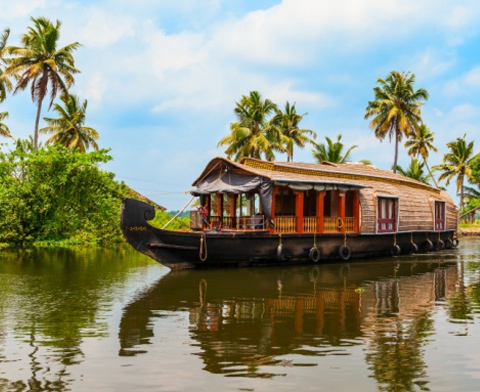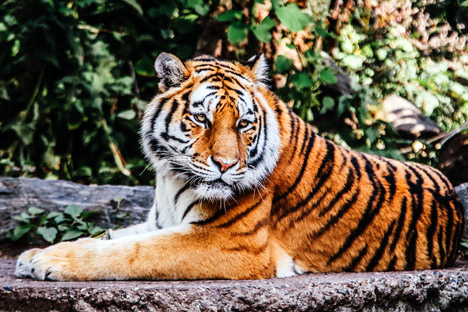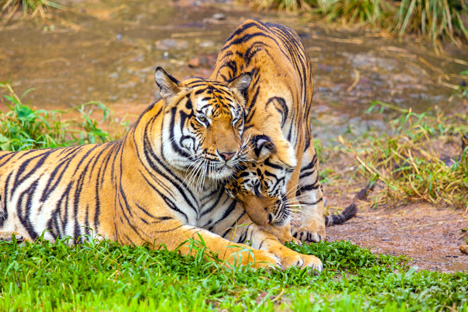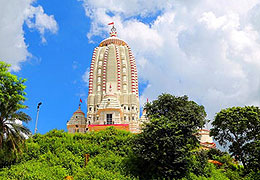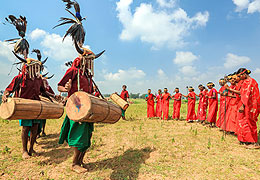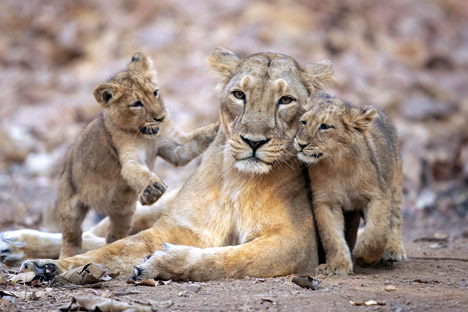History of Sariska National Park
The history of “Sariska National Park” dates back to the period before independence. Previously, the Kings or other regal individuals used this area as a private hunting retreat. Following independence, the circumstances changed, and the kings lost their royal authority. Common people started taking part in wild animal hunting for food and clearing land for farming. As a result, due to government indifference and ongoing hunting, the number of wild animals in this area has been steadily declining. However, in 1973, the Sariska Wildlife Sanctuary was not one of the nine reserves designated for the Tiger Project. The Sariska Wildlife Sanctuary was officially incorporated in 1979 as part of the Tiger Initiative.
Flora and Fauna of Sariska National Park
The Sariska National Park’s forests are dry deciduous, with Dhok as the prevailing tree type, with delicate to direct inclines constituting more than 90% of the tree shelter. The edges bolster Salar on steep, dry slants. Khair and Cheela happen in valley beds. Bamboo only grows to a limited extent in damp and colder areas. Aam, Jamun, Arjun, and Bahera grow in clammy despair and grow to enormous sizes on the nallah’s (water body) banks. The forests are rich green during the rainy season but completely dry in late spring.
The wildlife in the national park is abundant. The forest’s carnivores include the jaguar, hyena, jackal, and jungle cats. Rare sightings of caracals and wild dogs are common. Sambhar, Chital, Nilgai, wild boar, hare, porcupine, and other creatures are among the prey populations. The variety of animals in Sariska National Park is unique. Regarding the bird species, there are 225 varieties, including the gray partridge, sand grouse, crested serpent eagle, woodpecker, horned owl, tree pie, bush quail, and many others.
Places to Visit Near Sariska National Park
Sariska Tiger Reserve has several tourist attractions, including historic sites, mysterious forts, temple ruins, and picturesque lakes. In addition, you can drive to Alwar, which has its monuments and museum collections, while you are at Sariska Tiger Reserve. Some of the best places are:
Kankwari Fort
The Kankwari Fort is situated around 25 km from the reserve’s entrance. Dara Shikoh, the youngest son of Mughal Emperor Shah Jahan, was imprisoned here by his disobedient brother Aurangzeb in the 17th century. From October through July, the fort is open for business. From the fort’s vantage point, the jungle panorama is stunning.
Pandupol Hanuman Temple
The Pandavas are said to have spent their final year of exile in a location that can only be the present-day Sariska, according to the Mahabharata. Thus, the reserve has its share of historical temples. On Tuesdays and Saturdays, a continuous stream of people visits the Pandupol Hanuman Temple.
Neelkanth Temple
On a solitary hill in a buffer zone is the Neelkanth Temple for Lord Shiva. Amid the 300 temples that were thought to have been at this location at one time, the temple, built around the 10th century, stands regal in its architectural splendor. The temple is accessible through a sloping path and is open every day except Sunday.
Siliserh Lake
The artificial Siliserh Lake is a beautiful sight against the ancient Aravalli Mountains, and the Sariska Palace is located on its banks. Crocodiles, migrating birds, and other wildlife abound in the lake. Most of the nation’s crocodiles are found in Siliserh Lake, and as you stroll along the river’s banks, you can see them lounging on the grass.
Safari in Sariska National Park
Jeep Safari in Sariska
The Sariska jungle can be explored on a Jeep Safari for around 3:30 hours. A small party of six persons can explore the jungle and wild creatures in their natural habitat by taking a Jeep Safari.
Despite the fact that any six people can go on a Jeep safari, it is especially recommended for wildlife photographers since they can easily catch the exceptional moments of the Royal Tiger and other wild animals with their camera.
Winter timings
- Morning: 07:00 a.m. To 10:00 a.m.
- Evening: 02:00 p.m. To 05:00 p.m.
Summer Timings
- Morning: 06:00 a.m. To 09:00 a.m.
- Evening: 01:00 p.m. To 04:00 p.m.
Canter Safari in Sariska
Canter Safari is undoubtedly one of the pocket-friendly methods to experience Sariska National Park’s glory. It is a 20-seat open bus that departs from Sariska Gate (Gate 1) of the Sariska Tiger Reserve and is available for morning and evening sessions. When a large group of guests arrives, a canter is advised rather than making reservations for two or three jeeps. Sariska National Park’s Canter Safari should be reserved in advance because last-minute internet safari reservations are impossible. After providing the necessary information and ID documents, canters are rented online 90 days in advance.
Winter timings
- Morning: 07:00 a.m. To 10:30 a.m.
- Evening: 02:00 p.m. To 05:30 p.m.
Summer Timings
- Morning: 06:00 a.m. To 09:30 a.m.
- Evening: 03:00 p.m. To 06:30 p.m.
Night Safari in Sariska
The Sariska Tiger Reserve’s forest authorities offer Night Safari in the Sariska buffer zone. The second-largest cat in the world, the leopard, lives in the Alwar buffer zone of the Sariska Tiger Reserve. Because leopards are nocturnal (they travel at night), it is common to see them there, sometimes on the fort wall and other times on safari trails. The Sariska Tiger Reserve’s buffer zone tour will take visitors to Siliserh, Bala Quila, and the Dadikar forest area, among others. The officials claim that tourists are already interested in investigating the buffer zones and fauna.
- Winter timings: 05:30 p.m. – 07:30 p.m.
- Summer Timings: 06:00 p.m. – 08:00 p.m.
Hot Air Balloon Safari in Sariska
Sariska’s hot air balloon ride provides a spectacular journey above the Sariska Tiger Reserve and Bhangarh Village. The Sariska Tiger Reserve’s farthest village, Bhangarh, is where the hot air balloon flight takes off from. The Bhangarh Fort is said to be one of India’s most haunted locations, and this village is also well-known for its historical ruins.
The natural woodland environment and Bhangarh Village may be seen in stunning detail from the hot air balloon flight. The duration of the balloon flights, which generally last an hour in the morning (about 6 a.m.) and evening (around 4 p.m.), depends on the weather. Up to 8 to 11 people can ride in a hot air balloon at once. They are recommended for adventurous, first-time, and domestic travelers.
- Winter timings: 06:00 a.m. – 05:00 p.m.
Sariska Zones & Gates
This park has two gates to offer a wildlife experience, allowing you to access its four zones. These zones are denoted as Zone 1, Zone 2, Zone 3, and Zone 4. From all these zones, Zone 1 to Zone 3 is highly recommended for enjoying tiger sightings. Zone 4 has a slightly low chance of spotting tigers but is equally suitable for wildlife exploration. In addition, the gates also play a significant role in exploring the zones of Sariska National Park. The Sariska Gate has access to the three zones (Zone 1, Zone 2, & Zone 3). The second gate, Telha, is 80 km away from Sariska. These zones will follow the designated paths to cover, and the chances of spotting animals only depend on your luck. However, these zones are covered with vehicles that can make any difference in the wildlife experience. But they will both have to follow the same route the forest department has assigned.
Zone 1: This zone is one of the most visited by wildlife lovers as the chances of spotting animals are high. You will also have the option to choose both types of safari – Jeep and Canter.
Details of Route: Sariska – Ghanka tiraya – Tarunda – Brahmanath – Kalighati – Pandupol- Sariska
ZONE 2: This zone is not highly famous, but the chances are still high to spot wild species of animals. In addition, both safaris are available for this zone.
Details of Route: Sariska gate – Bharthari Tibara – Karnakabas – Jalebi Chowk – Algual – Naya pani – Geru ka tirya – Kalighati – Pandupole – Sariska
ZONE 3: This zone is also known as Zone 1 and is popular among wildlife enthusiasts and birdwatchers. You will get a better chance to spot birds here with both safari options.
Details of Route: Sariska gate – Bharthari Tibara – Karnakabas – Jalebi Chowk – Algual – Naya pani – Geru ka tirya – Kalighati – Pandupole –Sariska
ZONE 4: It is the least popular zone among all the zones of Sariska National Park and is located far away from the other zones. As per the reports, the sightings are also low, making it the least visited area of Sariska National Park.
Details of Route: Tehla gate – Chamari ka bera – Kalighati – Pandupole – Tehla
Resorts at Sariska National Park
Sariska National Park, situated in Rajasthan, offers a unique wildlife and natural experience. Here’s a list of resorts that provide a variety of accommodations, from eco-friendly to luxury, to cater to the diverse needs and interests of visitors seeking to explore Sariska National Park.
- Sariska Safari Lodge
- Sariska Palace
- Alwar Bagh Sariska by Aamod
- Vanaashrya
- Sterling Sariska
- The Tiger Den Resort
- Sariska Tiger Camp
- Siliserh Lake Palace
- Sariska – A Sterling Holidays Resort
- Sariska Heritage
